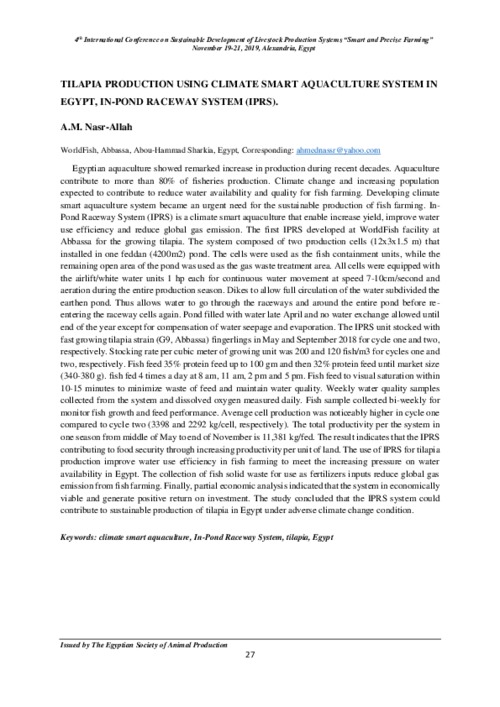Tilapia production using climate smart aquaculture system in Egypt, In-Pond Raceway System (IPRS)

Citation
Nasr-Allah, A. M. 2019. Tilapia production using climate smart aquaculture system in Egypt, In-Pond Raceway System (IPRS) (Abstract). Paper presented at The 4th International Conference on Sustainable Development of Livestock Production Systems "Smart and Precise Farming", Animal and Fish Production Department, Faculty of Agriculture, Alexandria University, November 19-21, 2019, Alexandria, Egypt.
Egyptian aquaculture showed remarked increase in production during recent decades. Aquaculture contribute to more than 80% of fisheries production. Climate change and increasing population expected to contribute to reduce water availability and quality for fish farming. Developing climate smart aquaculture system became an urgent need for the sustainable production of fish farming. In-Pond Raceway System (IPRS) is a climate smart aquaculture that enable increase yield, improve water use efficiency and reduce global gas emission. The first IPRS developed at WorldFish facility at Abbassa for the growing tilapia. The system composed of two production cells (12x3x1.5 m) that installed in one feddan (4200m2) pond. The cells were used as the fish containment units, while the remaining open area of the pond was used as the gas waste treatment area. All cells were equipped with the airlift/white water units 1 hp each for continuous water movement at speed 7-10cm/second and aeration during the entire production season. Dikes to allow full circulation of the water subdivided the earthen pond. Thus allows water to go through the raceways and around the entire pond before re-entering the raceway cells again. Pond filled with water late April and no water exchange allowed until end of the year except for compensation of water seepage and evaporation. The IPRS unit stocked with fast growing tilapia strain (G9, Abbassa) fingerlings in May and September 2018 for cycle one and two, respectively. Stocking rate per cubic meter of growing unit was 200 and 120 fish/m3 for cycles one and two, respectively. Fish feed 35% protein feed up to 100 gm and then 32% protein feed until market size (340-380 g). fish fed 4 times a day at 8 am, 11 am, 2 pm and 5 pm. Fish feed to visual saturation within 10-15 minutes to minimize waste of feed and maintain water quality. Weekly water quality samples collected from the system and dissolved oxygen measured daily. Fish sample collected bi-weekly for monitor fish growth and feed performance. Average cell production was noticeably higher in cycle one compared to cycle two (3398 and 2292 kg/cell, respectively). The total productivity per the system in one season from middle of May to end of November is 11,381 kg/fed. The result indicates that the IPRS contributing to food security through increasing productivity per unit of land. The use of IPRS for tilapia production improve water use efficiency in fish farming to meet the increasing pressure on water availability in Egypt. The collection of fish solid waste for use as fertilizers inputs reduce global gas emission from fish farming. Finally, partial economic analysis indicated that the system in economically viable and generate positive return on investment. The study concluded that the IPRS system could contribute to sustainable production of tilapia in Egypt under adverse climate change condition.
Permalink
Date Available
Type
Countries
Copyright
CC-BY-4.0
Research Themes
Language